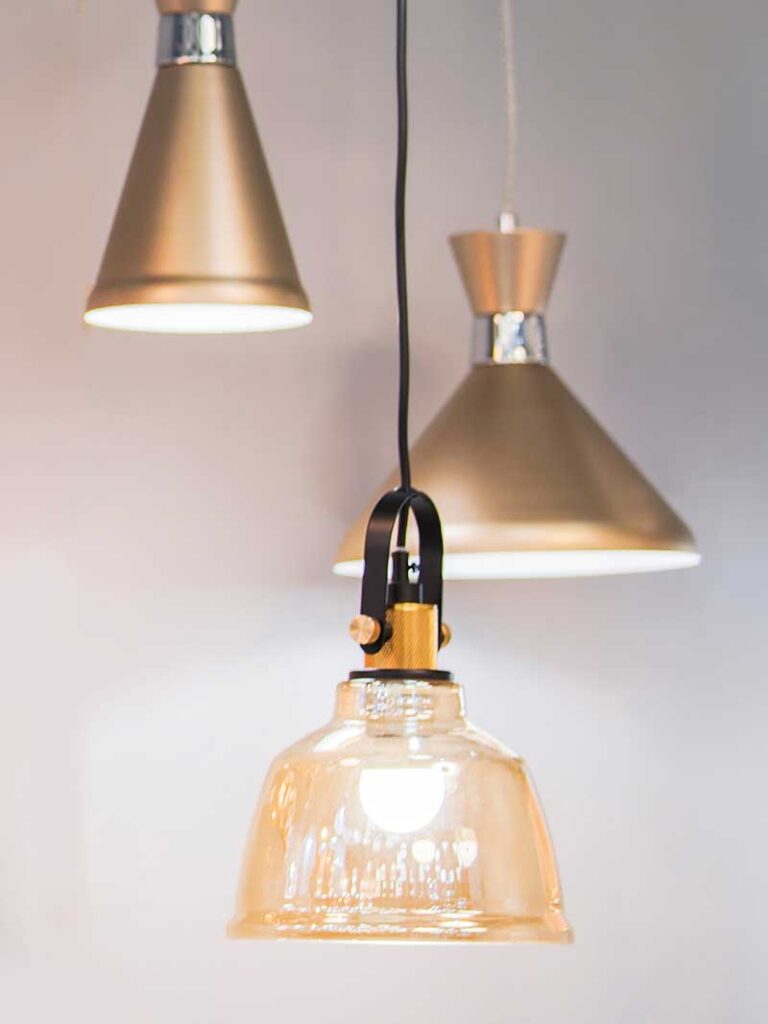
Would highly recommend.
Quick response and good workmanship
Thanks
Special thanks, also, to Steve's earnest contribution: not only for his positive and courteous attitude but also the due diligence and care consistently applied in terms of cleaning up after each stage in the whole process. Much admired and greatly appreciated.
Overall, I am very pleased with the entire experience and, as such, would happily recommend TM Hughes and Son to others.
TM Hughes & Son are NICIEC domestic installers who specialise in lighting design, installation, upgrades and repairs.
Call – 01702 911560
Our services cover both domestic and commercial properties in and around Southend.
- Indoor Lighting
- Exterior Lighting
- Security Lighting
- Free Quotes
- Emergency Call Outs
- No Call-Out Charges
Domestic Lighting
New lights can significantly enhance the look and functionality of your home, both inside and outside.
Everyone has different requirements when it comes to Lighting.
When designing and building a new lighting installation, there’s more to it than picking lights you like the look of and fitting them.
That’s why it pays off to use qualified Electricians with years of experience in lighting installation.
When fitting new lights, we’ll discuss your needs, wants and individual preferences regarding the actual look and design of the lights themselves.
Security-lit homes and businesses suffer from less vandalism/theft than those without, which crime statistics have shown. Every property has dark, vulnerable areas which should be protected by security lighting.
Security lighting can be timed so it’s on throughout the hours of darkness. A more economical version is motion sensor lighting which switches on whenever anyone walks past the sensor attached to the light.
Security lighting is fitted with the latest energy-saving bulbs and works well for the following areas.
- Driveways
- Garages
- Sides of house
- Front of house
- Backdoor
- Outdoor Walkways
- Sheds
- Entrances
- Fire Escapes
- Sides of building
- Vulnerable windows
- Shutter doors
- Dimly lit parking areas
- Outdoor storage areas
Commercial Lighting
We design and build lighting installations for the businesses of Southend. Whether your operation is big or small, we can help you, from small catering establishments to large factories.
There are lots of commercial properties in the Southend area with old, inefficient lighting. A new installation combined with the latest energy-saving bulbs can save your business money in running costs.
New Lighting could enhance the day-to-day running of your business and employee productivity. Studies have shown optimal lighting levels enhance mood, energy and alertness, which leads to better productivity. For the best results, combine your workplace lighting with as much natural light as possible.
Optimal Lighting is also better for health and safety.
One of our experienced commercial lighting electricians can design an installation to achieve this. Let us visit you to undertake a free survey and write a free, no-obligation quote.
The Planning Stage
Lighting is as important as any other rebuilding work and should be planned from the start to work in line with any building, refurbishment or landscaping work.
If no refurbishment work is taking place, the installation is designed to work with the existing space.
Several factors are established to design the perfect installation for any given space to design and fit the best possible Lighting for your situation.
A Note On Building Regulations
Whether they are on a domestic or commercial property, all lighting installations must be installed by a certified electrician and adhere to the current building regulations.
TM Hughes & Son Electrical Services is an NICEIC domestic installer. Our electricians are qualified to install Lighting and always work within the building regulations.
All work undertaken is provided with the relevant certification (electrical installation certificate), so you can prove everything’s been done correctly.
We are also happy to work with any existing plans provided by a builder, architect or landscape gardener.
Room Dimensions
Every space is measured wall to wall and floor to ceiling. Once we know the size of the room and the number of lights desired, we can work out the number of bulbs, colours and wattages needed.
Room Function
Lighting and bulbs are determined mainly by the room’s function. Bathrooms require the most light, while hallways require the least. Kitchens, living rooms and bedrooms sit somewhere in the middle, and all require different light levels.
Occupation Of Room
What time of day is each room used? Rooms used mainly during the day generally need less light than rooms used primarily at night.
Age Of Occupants
As age increases, so do lighting needs. A younger person has better eyesight than an older person with an eye condition, so they won’t need as much light. The age of occupants helps us decide bulb strength.
Windows
A room with multiple windows will receive more natural light than a room with a single window. Window areas are not purposely highlighted or enhanced by Lighting.
Natural Light
Your windows will provide natural light. South-facing windows provide more light throughout the day than north-facing windows. The direction of the natural light and the time of day the rooms occupied are considered here.
Radiators
Unless you have expensive designer radiators picked to work with your decor, you won’t want to give them extra attention to Lighting. Lights are usually kept away from radiators.
Architectural Features
Feature walls, fireplaces, vaulted ceilings and alcoves can be made to stand out with directional or uplighting.
Furniture
Where’s your furniture placed, and what’s the purpose? A reading chair will be well served by a multidirectional wall spotlight, whereas a dining table will benefit from a row of low-hanging pendants.
Light Switches
Are your light switches in a convenient position? If not, they can be repositioned, so you never again have to walk through a dark room before or after turning off the lights. Do you require 1,2,3 way switches, dimmer switches or the latest smart switch?
Most Importantly
What design, colour and style of lights and switches appeal to you the most? There are many to choose from. If you are unsure, we can help you pick the best-looking lights to go with your decor and furniture. The lights fitted will be to your unique preferences.
Types Of Light
There are several types of light available for lighting your home. We install them all. The type of light used and the positioning will depend on what you need each specific light for. Different types of lights are fitted to work together to achieve the desired light levels and effect for each room.
A light is not just a light; different lights serve different purposes.
Standard Ambient Lights
The standard lights illuminate each room so you can use and navigate safely when no or little natural light is available.
Task Lights
Extra Lighting that aids in your day-to-day tasks.
Accent Lights
Decorative lights are used to add an extra edge to the space’s look or unique features.
Outdoor Lights
Outdoor lights illuminate outdoor living areas, walkways, and architectural features and provide a security element.
Down Lights
Downlights are fitted to the ceiling and illuminate downwards. Standard ceiling rose, flush and recessed lights are common downlights. Downlights are common in most homes.
Up Lights
Uplights shone upwards. The lights then diffused and bounced off the ceiling back down onto the room. Up Lights work best with white ceilings. Up-lighters are generally fitted to walls.
Directional Lights
Adjustable spotlights are good examples of directional lights pointed in a specific way to light a certain area or feature.
Ambient Lights
Ambient lights fall into several categories.
Pendants – Pendant lights are suspended via a cable and sometimes a chain (for heavier designs). Standard Pendant lights have a single bulb, while others may have two or more bulbs.
Chandeliers – Chandeliers are perfect for high ceilings as they hang considerably low. They are usually highly decorative featuring multiple bulbs. Many designs of Chandeliers are available, from minimal to highly extravagant.
Flush – Compact lights with a thin profile that sit ‘flush to the ceiling, ideal for bathrooms and low ceilings.
Semi-flush – Semi-flush lights hang a few inches from the ceiling and are ideal for homes with mid-height ceilings.
Track – Several adjustable lights sit inside a track. The lights can be moved and pointed in various directions, allowing you to light several areas from a single light fitting.
Recessed – Recessed lights sit inside the ceiling, the best light for homes with the lowest ceilings or when you want multiple spots pointing downwards. Some are adjustable and can be used to highlight wall features.
Wall Lights
Wall lights can be used on their own to illuminate the room or used in combination with ceiling lights.
Single Arm – The bulbs are fitted to an arm that sticks out of the wall. Some arms are longer and adjustable. The bulbs can be covered with a lampshade or naked.
Double Arm – Feature two arms and two bulbs. Lower-strength bulbs (lower than a single arm) are fitted. Again it can be covered or naked.
Uplighters – The bulbs are covered, so the light points up and reflects off the ceiling.
Up & Down – Features two bulbs that illuminate up (lighting the room) and down (lighting the wall for decorative effect).
Flush – A slim profile light that can shine out, up or down (or both).
Strip – Attached to an arm strip, lights illuminate pictures or mirrors.
Outdoor Lights
Outdoor Lighting is highly versatile, serving multiple uses and illuminating your outdoor living spaces, which makes them pleasant to sit in while showing off the architectural features of your home. Exterior Lighting provides safety and security; the chances of an accident or criminal activity after dark are greatly reduced when the lights are on.
Combining motion sensor security lighting with exterior Lighting works well for most homes with outside spaces. Motion sensor lighting illuminates dark garage areas, driveways and pathways, providing safety while deterring intruders.
The following lights are available for illuminating outdoor living areas and the exterior walls of your property. We fit most exterior Lighting with the latest energy-saving LED bulbs. Some installations require other bulbs, but we always ensure exterior lighting installations are as energy-efficient as possible.
Wall Lights
The most common type of outdoor light wall lights is probably available in many designs, including flush wall lights, adjustable spotlights, arm wall lights, and brick lights, which fit inside the wall in place of brick.
Ceiling Lights
Exterior alcoves such as porches are illuminated with ceiling lighting. Flush and recessed Lighting is trendy in these situations. Ceiling pendant lights (hanging from a cable) are also available.
String Lights
A string of bulbs stretches across your garden, providing lots of light while adding in lots of character. Ideal for outdoor seating areas and parties.
Floor Lights
Floor lights sit on the floor, pointing up at an angle to illuminate walls. Recessed floor lights sit inside the floor, pointing directly upwards, a popular choice for decking.
Post Lights
Lights fitted into posts that are installed in the ground are ideal for lighting up pathways.
Light Bulbs
Bulbs finish off your lighting installation. Many different bulbs vary in size, shape, colour, power and type. The right bulb for any given light will depend on several factors, such as the size of the room, the number of lights in the room, the purpose of the light etc. Our lighting electricians are experts at picking the correct bulbs for lighting installations.
Types Of Light Bulb
Incandescent
Incandescent bulbs are cheap to buy and, for over a century, dominated the light bulb market here and abroad. The incandescent was evolved from the original light bulb invented by Thomas Edison. A filament wire is installed inside an airtight glass when electricity flows through the filament and illuminates light. Incandescents are expensive to run, so modern energy-saving bulbs are replacing them and, at some point, will no longer be available. It’s, for this reason, all lights installed to utilise the latest LED bulbs.
Halogen
Halogen bulbs contain low-pressure hydrogen gas, which glows when powered by electricity. Halogen bulbs are more energy-efficient than incandescent bulbs. However, Halogens, which get hot quickly and don’t last long, are not as efficient or as friendly to the environment as modern LED bulbs.
CFL
CFL Bulbs (compact fluorescent lamps) are energy-efficient alternatives to Incandescent and Halogen bulbs. CFLs were first released to the public in 1995. While they are efficient, they are big and ugly to look at and also contain mercury. CFL bulbs are also stepping aside for the latest LED bulbs.
LED
LED (light-emitting diode) is THE bulb to have. LEDs run cool (incandescent and halogen bulbs heat up quickly), last a long time (up to 50 times longer than incandescent bulbs) and are extremely energy efficient compared to the other types of light bulbs. LED bulbs require more investment upfront but cost less in the long run (energy bill savings). Smart LED bulbs, which are controllable via an app on your phone, are also available.

Hi, I’m Terry, the founder and owner of TM Hughes & Son Electrical Services
Please get in touch to book an appointment or receive a free, no-obligation quote
Call: 01702 911560



